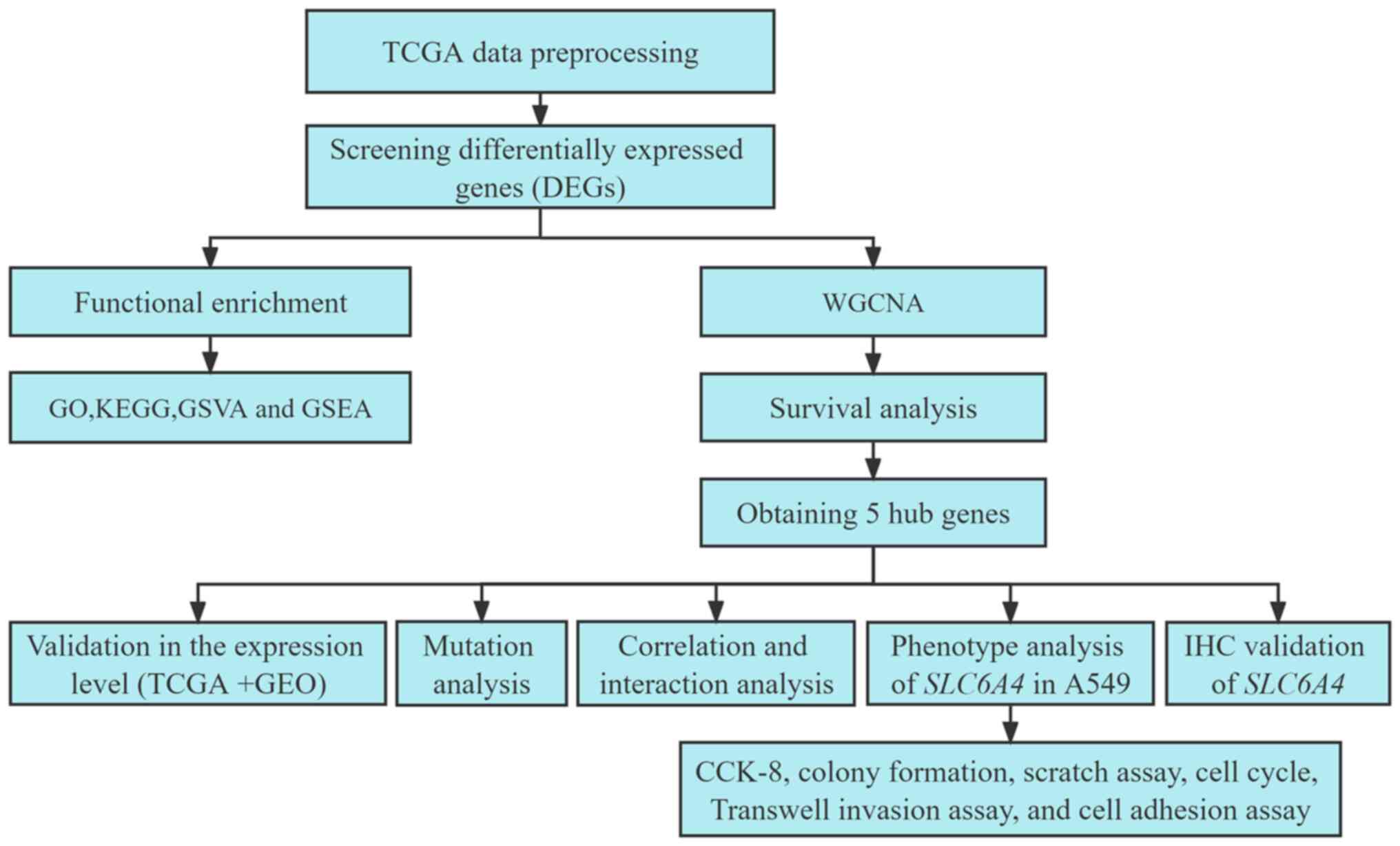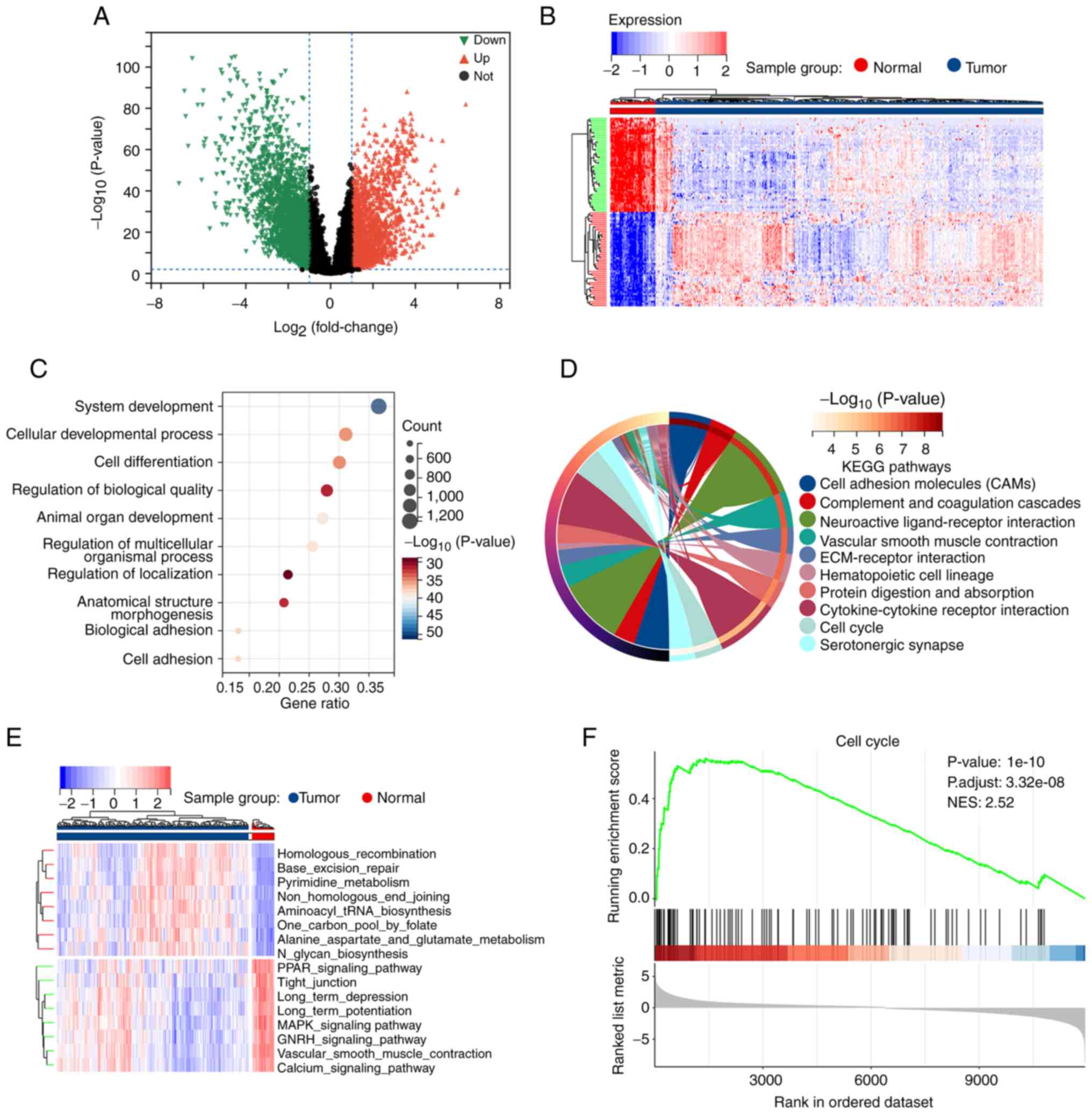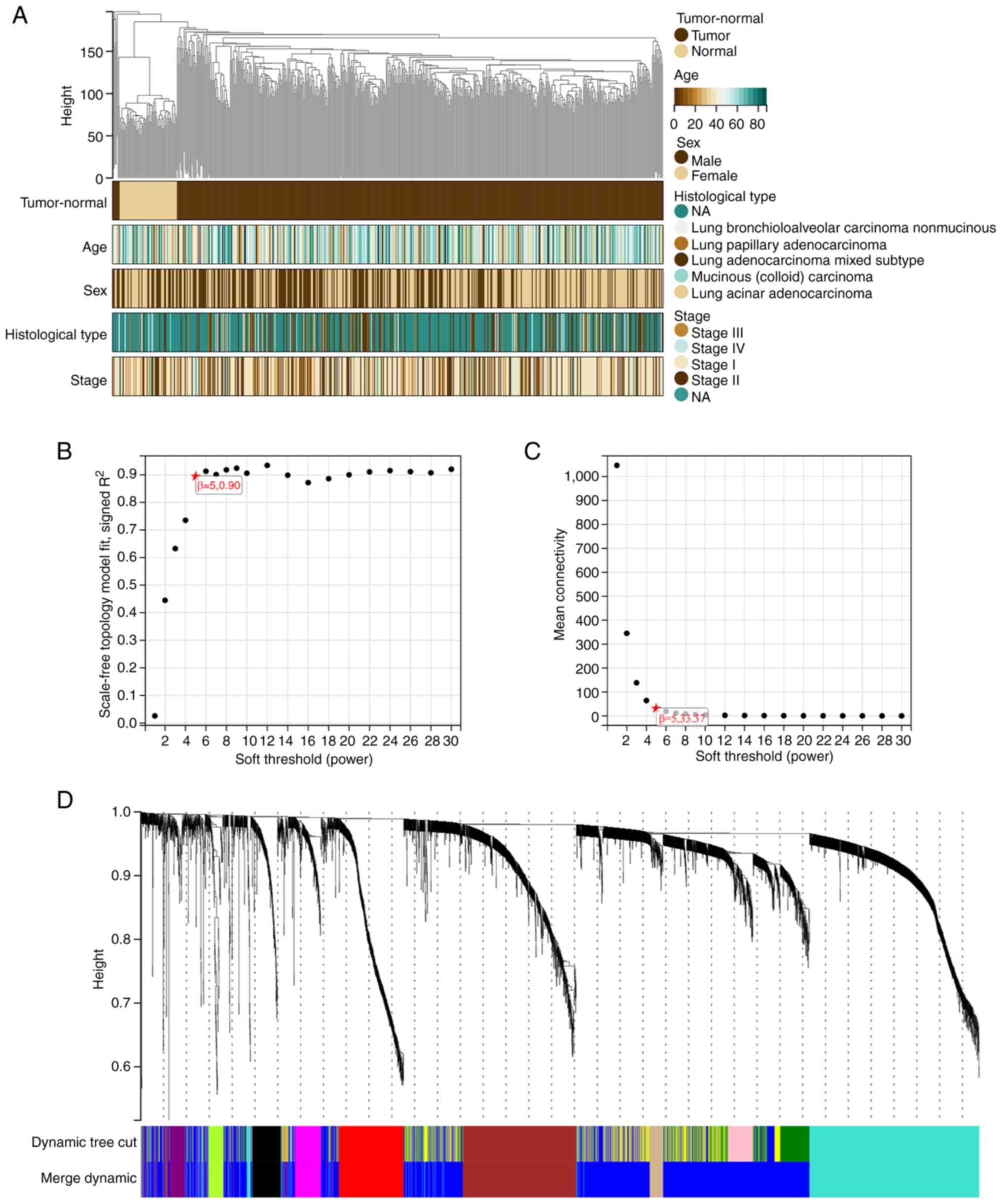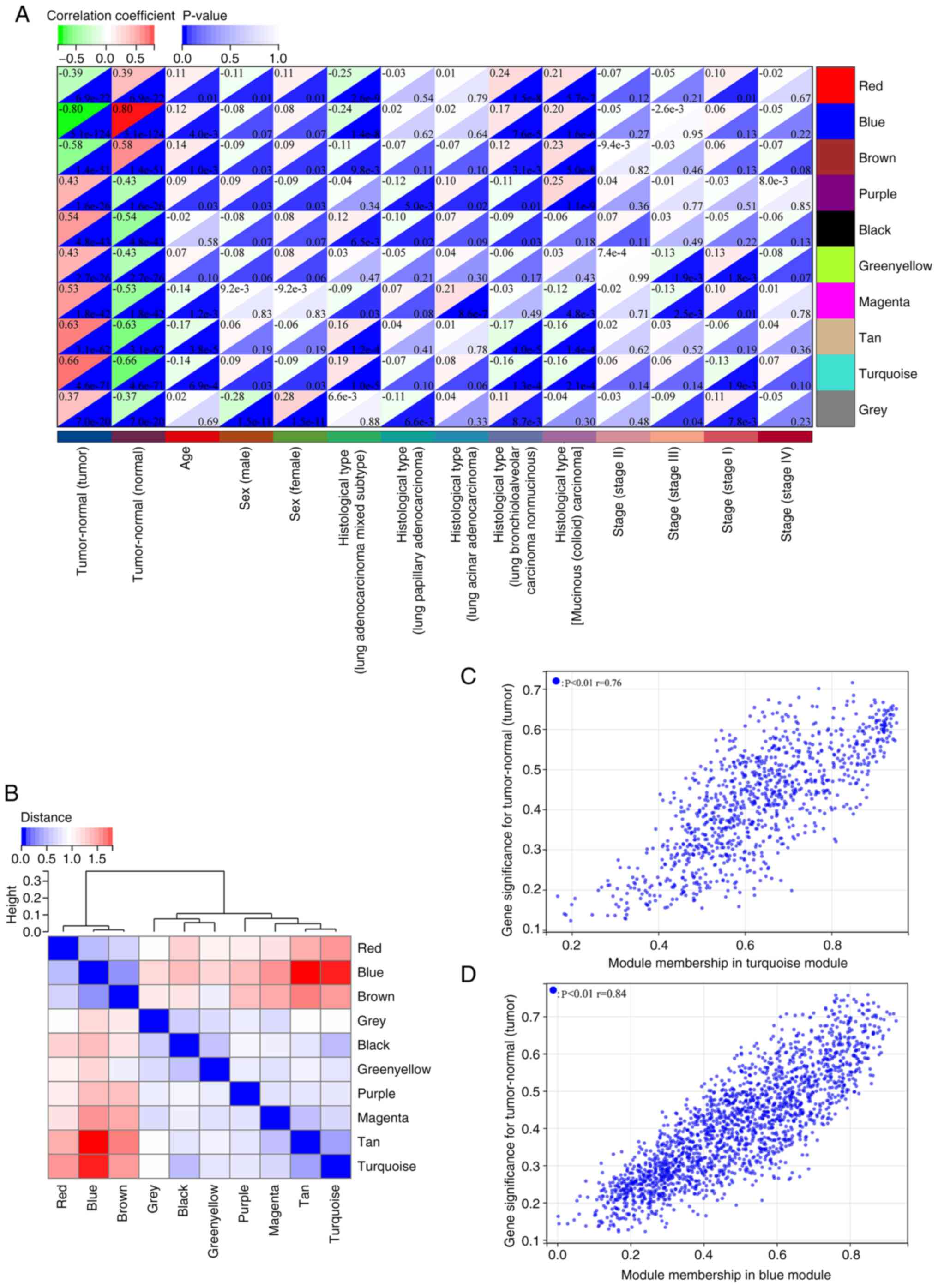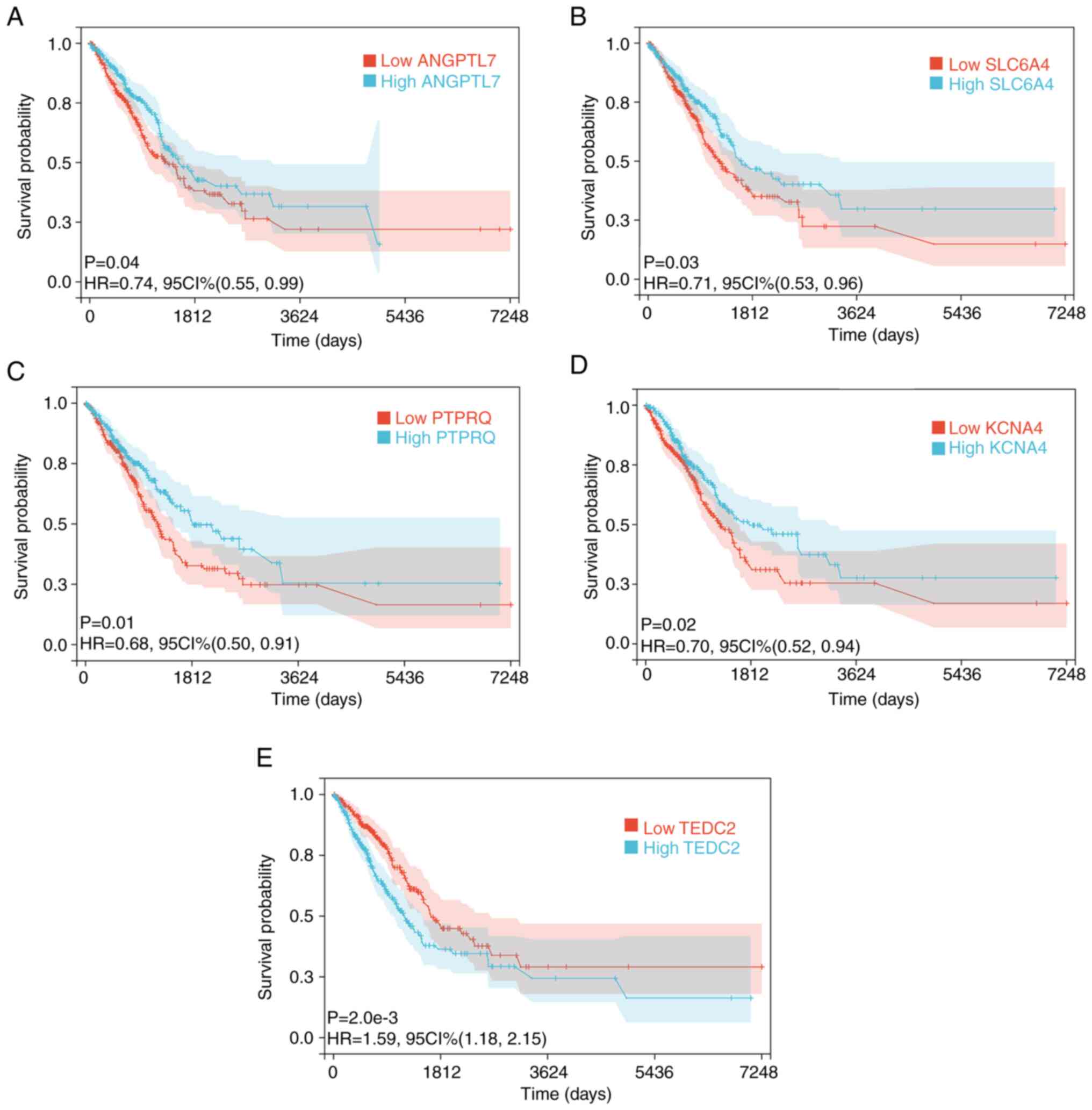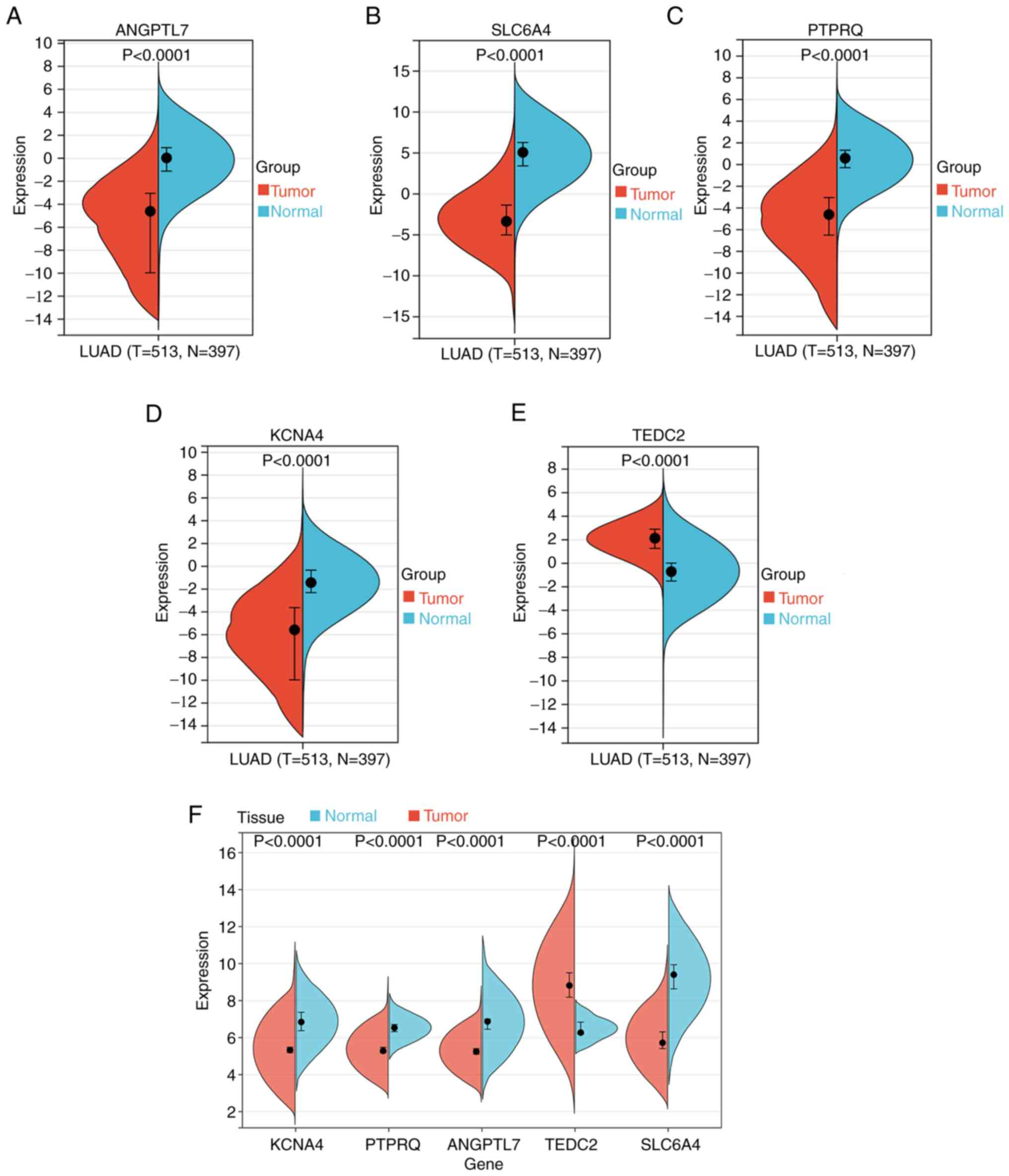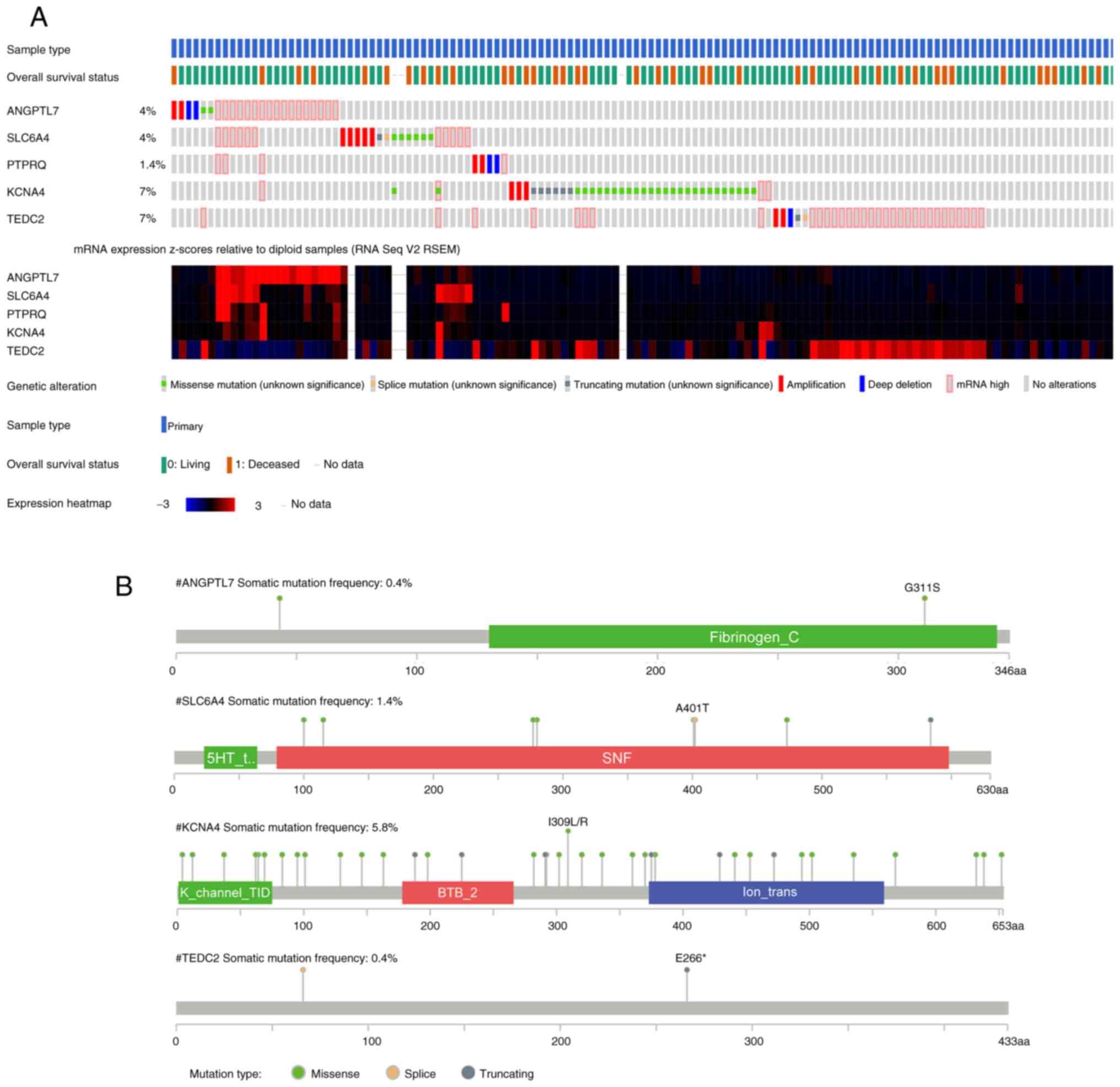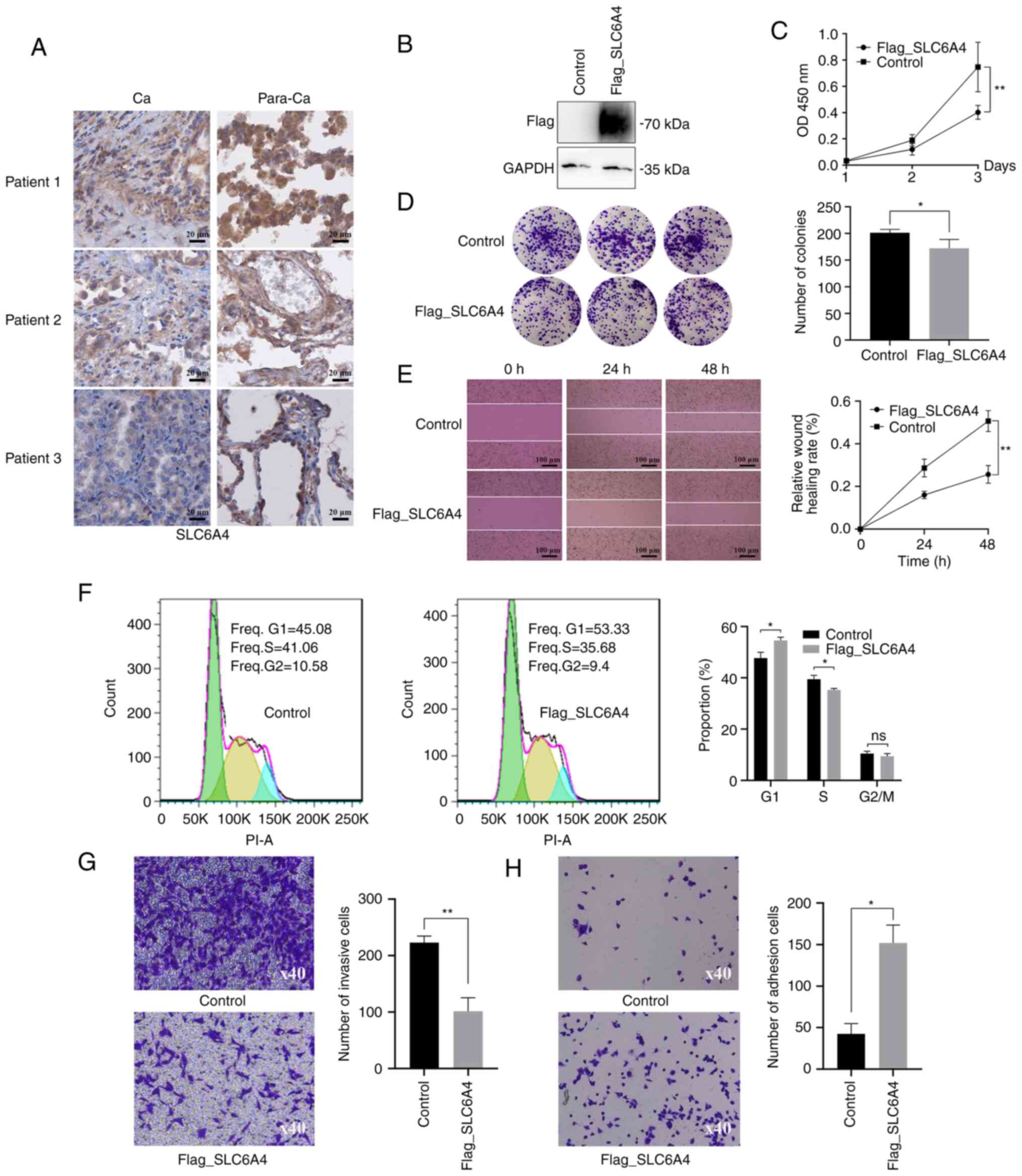Identification of potential prognostic markers for lung adenocarcinoma using comprehensive analysis
- Authors:
- Published online on: June 20, 2023 https://doi.org/10.3892/mmr.2023.13036
- Article Number: 149
-
Copyright: © Huang et al. This is an open access article distributed under the terms of Creative Commons Attribution License.
Abstract
Introduction
Lung cancer has both high prevalence and a high mortality, with over 2 million new diagnoses and 1.7 million cancer-related deaths per year (1). The most common types are lung adenocarcinoma (LUAD) and lung squamous cell carcinoma (LUSC). LUAD has a high prevalence (2–4) with a 40% contribution to all diagnosed cases of lung cancer (5). Despite improvements in clinical prognosis due to advances in diagnostic methods, surgery, and adjuvant and molecular therapeutics (6), the five-year survival rates remain low (7,8).
Tumor markers in patient sera are frequently employed for the diagnosis and differential diagnosis of lung cancer. These include carcinoembryonic antigen (CEA), cytokeratin-19-fragment (CYFRA21-1), squamous cell carcinoma antigen, neuron-specific enolase, and pro-gastrin-releasing peptide (9,10). CEA and CYFRA21-1 have been revealed to be markedly increased in the sera of patients with LUAD and to be associated with pathological types and clinical stage (11). In addition, CYFRA21-1 or CEA in the serum may also be used as a marker for evaluating the efficacy of immunotherapy in LUAD (12). The use of marker combinations can also improve the sensitivity and accuracy of diagnosis, as well as the accuracy of distinguishing between different tissue types (10). However, serum levels of CEA (13) and CYFRA21-1 are often increased in other cancers and non-cancer diseases, and the sensitivity of a single marker for lung cancer screening was identified to be <65% (14). These issues may lead to false-positive/negative results. Furthermore, other traditional diagnostic techniques lack sufficient sensitivity and specificity for early diagnosis. These include computed tomography, fiberoptic bronchoscopy and chest radiography (11). Therefore, the search for additional markers for use in combined diagnosis is of great importance in LUAD.
Next-generation sequencing has created new avenues for studying the genomic, transcriptomic, and epigenomic features of tumors (15). Network analysis, in particular, can be used to apply systems biology methodologies for the successful integration of data from multiple large-scale databases containing data on cancers and other complex human diseases. It allows the investigation and analysis of processes in terms of molecular interactions (16–19). For instance, weighted gene co-expression network analysis (WGCNA), a systems-biology approach, is an accurate and effective approach for multi-gene research (20–22). The R package ‘WGCNA’ can be used to analyze the various components of the weighted correlation network analysis (20,23). Associations between multiple genes or across clinical samples and expression profiles can be examined through scale-free networking (20). WGCNA is frequently used to identify key hub genes and modules in multiple tumor types. A previous study used competitive endogenous RNA (ceRNA) network analysis and WGCNA to determine hub genes associated with breast cancer prognosis (24). In another study, 21 key genes that could act as possible therapeutic targets in hepatocellular carcinoma were identified using WGCNA (25). Furthermore, in a previous study the top 10 hub genes related to poor patient prognosis in glioblastoma were identified using WGCNA (26). In the present study, WGCNA was used for the identification of five novel LUAD-associated hub genes and one was selected to verify its biological function.
RNA sequencing data on LUAD tissues were obtained from The Cancer Genome Atlas (TCGA), and differentially expressed genes (DEGs) between LUAD and adjacent healthy tissue were identified. Functions of the DEGs were examined and WGCNA was employed to identify associations between gene expression and clinical features. Hub genes were verified with survival analysis, and were validated against other databases. The results of the present study offer new insights into LUAD pathogenesis and the five identified hub genes may have potential as markers or drug targets for treating LUAD.
Materials and methods
Data collection and handling
Data, including information on clinical features and RNA sequencing, were obtained from TCGA-LUAD dataset on the UCSC Xena website (https://xena.ucsc.edu/). The RNA sequencing data were derived from 517 tumor and 59 normal tissues. Tissues from non-primary tumors and outlier samples were excluded through principal component analysis (PCA), performed by ‘stats’ package in R (v. 3.6.0; developed by the R core team and contributors worldwide). Specifically, gene expression profiling was normalized by z-scores, and further dimensionality reduction analysis was conducted using the ‘prcomp’ function to obtain the corresponding matrix. Clinical parameters, including sex, smoking history, stage and histological type, were analyzed using chi-square tests (Table I). The procedures used in the present study are revealed in Fig. 1.
Table I.Clinical data and number of samples for The Cancer Genome Atlas lung adenocarcinoma dataset. |
DEG identification and functional enrichment
The ‘limma’ package in R (v. 3.40.6), a generalized linear model-based differential expression screening application, was used for DEG identification (27). Gene expression was examined with linear regression with the ‘lmFit’ function. The ‘eBayes’ function was used to calculate moderated F-stastistics, moderated t-statistics, and log-odds of differential expression based on the empirical Bayes moderation of standard errors. Gene significance levels were determined. DEGs were identified using log2 (fold change) with the criteria of |log2 (fold change)| >1 and P<0.01. R was used for preparing volcano plots.
Functional analysis of the DEGs was undertaken with Gene Ontology (GO) and Kyoto Encyclopedia of Genes and Genomes (KEGG) using the ‘clusterProfiler’ (v. 3.14.3) package in R (27). The GO database has the following categories: Cellular component (CC), biological process (BP), and molecular function (MF). The file containing the DEGs was used as the foreground and the full list of genes was added as the background along with an annotation information file. P-values <0.05 were considered statistically significant.
To examine changes in signaling pathways between tumors and normal tissues, Gene Set Variation Analysis (GSVA; v.1.40.1; http://bioconductor.org/packages/release/bioc/html/GSVA.html) was performed based on KEGG gene-set from molecular signature database (MSigDB; http://www.gsea-msigdb.org/gsea/msigdb) using the ‘GSVA’ R package. Differences between groups in the same dataset were analyzed with Gene Set Enrichment Analysis (GSEA; http://www.gsea-msigdb.org/gsea/index.jsp).
WGCNA
The ‘WGCNA’ package (v.1.72.1) in R was used for construction of the DEG co-expression network (20,28). Initially, Pearson's correlation coefficient matrices and average linkage were created across the entirety of pair-wise gene comparisons. Subsequently, a weighted adjacency matrix was created employing the power function A_mn=|C_mn|^β (C_mn=Pearson's correlation across genes m and n; A_mn=adjacency across genes m and n). Utilizing the ‘pickSoftThreshold’ function of ‘WGCNA’ package, a suitable soft threshold power (β) guaranteed scale-free networking, emphasizing strong gene-gene correlations while penalizing poor correlations. Finally, the adjacency matrix was changed to a topological overlap matrix (TOM) to assess the connectivity within the gene network. The related dissimilarity was calculated as 1-TOM. Genes with the same expression patterns were grouped by average linkage hierarchical clustering. Each gene group contained at least 30 for incorporation into the dendrogram using the TOM-based dissimilarity metric (29,30).
The module eigengene, obtained by performing PCA on all genes within a module, was used to describe the overall gene expression within that module (15). To identify clinically significant modules, associations across module eigengenes and clinical features were assessed. Linear correlations between clinical parameters and gene expression profiles were attributed a gene significance (GS) value. Module membership (MM) was obtained by examining correlations between the expression of the genes within the module and module eigengenes. The key genes of the module were assumed to be connected with LUAD if the GS was highly associated with MM (31,32). These central genes were considered alternative hub genes.
Survival analysis
Initially, 19 hub-gene expression profiles/prognosis datasets were obtained for 488 LUAD specimens. After integration of survival time/status with gene expression profiles using the R ‘survival’ package (v.3.3.5; http://github.com/therneau/survival), univariate Cox regression was performed to assess each gene's prognostic value. In addition, survival differences between patients with increased and decreased expression were analyzed using Kaplan-Meier survival curves with medians as cut-offs. A gene was considered a hub gene if the log-rank test yielded a P-value <0.05.
Bioinformatics validation
The respective levels of hub genes in the tumor and control tissues were analyzed in datasets from TCGA/Genotype-Tissue Expression (GTEx; v.8; http://gtexportal.org/home/). The Gene Expression Omnibus (GEO) GSE116959 dataset (33) was used for validation. Non-parametric tests were used with differences considered statistically significant at P<0.05.
Correlation and interaction analysis
Based on the expression profile used in the current investigation, Spearman's correlation analysis was performed using GraphPad Prism (v.8.0.2; GraphPad Software, Inc.) between the five hub genes and tumor suppressor genes (RB1, TP53 and PTEN). Additionally, the analysis in STRING (v. 11.5; http://cn.string-db.org/) was conducted to determine whether there is an interaction between them.
Mutation analysis
The LUAD dataset was accessed and analyzed on the cBioPortal website (https://www.cbioportal.org/). To this end, 566 samples from the ‘Lung Adenocarcinoma (TCGA; Pan-Cancer Atlas)’ dataset were used to analyze genetic alterations and transcriptomic expression z-scores (RNA Seq V2 RSEM) in the hub genes. Additionally, Mutation-Mapper tools in cBioPortal were used for visualizing the mutation landscape of the hub genes.
Immunohistochemistry (IHC)
The downregulated gene SLC6A4 with the greatest difference was selected for immunohistochemical verification. IHC was carried out on tumors and paired normal tissues obtained from three patients with LUAD. Tissue sections were purchased from Wuhan Shuangxuan Biotechnology Co., Ltd. (http://www.whshuangxuan.com/h-pd-23.html; cat. no. IWLT-N-106AL94). IHC on the tissue sections was performed by Guangxi Kingmed Diagnostics Group Co., Ltd. (author JW was involved in the staining of the tissues). The tissues were fixed in 10% formalin (1 h, room temperature), paraffin-embedded and cut into 2–3 µm sections, which were mounted on adhesion microscope slides (CITOGLAS; Jiangsu Shitai) and left at 70–80°C for 20 min. The adhesion microscope slides were then deparaffinized in xylene, followed by rehydration in an alcohol gradient and rinsing with tap water and antigen retrieval in Tris-EDTA, pH 9.0. Following washing with tap water, the sections were submerged in peroxidase blocking reagent (3% H2O2) at room temperature for 20 min. The sections were incubated with an anti-SLC6A4 antibody (1:100 dilution; cat. no. 19559-1-AP; ProteinTech Group, Inc.) for 30 min at 37°C. Antibody binding was detected using the ‘Novolink Max Polymer Detection System’ (Leica Biosystems, Inc.), in which incubation was performed for 30 min at 37°C using ready-to-use HRP-conjugated secondary antibodies (cat. no. RE7161; ready to use; Leica Biosystems, Inc.). The sections were counterstained with hematoxylin for 1 min at room temperature. Finally, the IHC images were captured under a light microscope.
Cell culture and transfection
Human lung adenocarcinoma A549 cells (MeisenCTCC; cat. no. CTCC-001-0036) overexpressing SLC6A4 were cultured in DMEM (MeisenCTCC; cat. no. CTCC-002-008). Media were enriched with 10% fetal bovine serum (NEWZERUM, Ltd.) with 100 U/ml penicillin and 0.1 mg/ml streptomycin. Cells were grown at 37°C in a humid incubator plus 5% CO2. The SLC6A4 expression plasmid was constructed by subcloning PCR-amplified SLC6A4 cDNA (YouBio; cat. no. G158402) into the pHAGE-flag vector. For transfection, A549 cells at ~80% confluence were transfected with plasmids with Lipofectamine™ 2000 (Invitrogen; Thermo Fisher Scientific, Inc.) according to the manufacturer's instructions. An empty vector was used for the control. In the following experiments, ‘Flag_SLC6A4’ represents the exogenous expression of SLC6A4, where ‘Flag’ (amino acid sequence: DYKDDDDK) is a fusion tag.
Western blot analysis
Cells were collected 36–48 h after transfection. Cells were lysed using SDS lysis buffer (0.05 mol/l Tris-HCl, pH 6.8, 2% SDS and 10% glycerol) for 10 min at 95°C. The protein concentration was measured using a bicinchoninic acid (BCA) protein assay kit (cat. no. BL521A; Biosharp Life Sciences). The proteins (30–50 µg) were separated by 10% SDS-PAGE and transferred to PVDF membranes (product no. IPVH00010; MilliporeSigma). Following blocking with 5% skimmed milk for 1 h at room temperature, the membranes were incubated with primary antibodies against SLC6A4 (1:1000 dilution; cat. no. 19559-1-AP; ProteinTech Group, Inc.) and GAPDH (1:5,000 dilution; cat. no. AG8015; Beyotime Institute of Biotechnology) overnight at 4°C. The blots were then probed with HRP-conjugated secondary antibodies (1:2,000 dilution; cat. no. A0208; Beyotime Institute of Biotechnology) for 60 min at room temperature. Subsequent to washing with TBST, immunoreactive proteins were visualized using enhanced chemiluminescent (ECL) kit (BeyoECL Star; cat.no. P0018AM; Beyotime Institute of Biotechnology) and imaged by chemiluminescence (Tanon 5200; Tanon Science and Technology Co., Ltd.).
Cell Counting Kit-8 (CCK-8)
Cell proliferation was evaluated using CCK-8 (Biosharp Life Sciences), following the provided instructions. Cells (500 per well) were added into 96-well plates. The CCK-8 solution (1:10 diluted with DMEM) was added to each well after 8 h of incubation. At time periods spanning from 1 to 3 h after incubation (37°C), the absorbance at 450 nm was read using a microplate reader.
Colony formation
Colony formation was assessed in SLC6A4-overexpressing A549 cells. For both the experimental and control groups, the same number of cells (400/well) was seeded into six-well plates and grown for 14 days, after which colonies were fixed with 4% paraformaldehyde (30 min, room temperature) and stained with 0.025% crystal violet (15 min, room temperature), followed by two washes with PBS. The number of colonies with >50 cells was counted under a microscope. Images of colony formation were captured using a camera (BRQ-AN00; Huawei).
Scratch assay (wound-healing assay)
Cells were allowed to grow in six-well plates until 90% confluent. A micropipette tip (200-µl) was employed to create a straight scratch in the monolayer, and free-floating cells and debris were gently removed with PBS. Cells were then cultured in serum-free medium. An inverted fluorescence microscope (MF52-N; Guangzhou Micro-shot Technology Co., Ltd.) was used to observe and image the cells at 0, 24 and 48 h. The results were analyzed using ImageJ software (v.1.51; National Institutes of Health).
Cell cycle
Single cell resuspensions (1×106 cells/ml) were washed with pre-cooled PBS before being gently mixed using pre-cooled 70% ethanol and fixed for 4 h at 4°C. Following fixation and washing, cells were stained with 500 µl PI/RNase A (Biosharp Life Sciences) at 37°C for 30 min in the dark. Cell cycle distributions were examined with flow cytometry (FACSCantoII; BD Biosciences) and analyzed with Flowjo software (v.7.6.1; BD Biosciences).
Transwell invasion assay
A Transwell chamber (Corning, Inc.) pre-coated (2 h, 37°C) with Matrigel (Beyotime Institute of Biotechnology) was used for the Transwell invasion assay. A total of 500 µl of DMEM with 40% FBS were placed into the lower chamber, and cells (4×104 cells/well) in serum-free DMEM were placed in the upper chamber. Following incubation for 24 h at 37°C, the cells on the lower surface were fixed with 4% paraformaldehyde (Beijing Solarbio Science & Technology Co., Ltd.) for 10 min at room temperature and stained with 0.1% crystal violet for 15 min at room temperature. Cells on the lower surface were imaged under an inverted microscope.
Cell adhesion assay
For the cell adhesion assay, 96-well plates were coated with 20 µg/ml fibronectin (50 µl per well, overnight at room temperature; Beijing Solarbio Science & Technology Co., Ltd.). After washing with PBS and the addition of 200 µl of 1% heat-denatured BSA, the plate was allowed to stand for 1 h at 37°C. Cells (4×104 cells per well) were inoculated into the plates and settled at 37°C for 1 h before rinsing in PBS, fixing, staining and imaging as above in the section on the Transwell invasion assay.
Statistical analysis
All in vitro experiments were repeated at least 3 times. The mean ± standard deviation was used to present the data. The unpaired t-test was performed to compare two groups with a normal-distribution. Statistical analysis was conducted using GraphPad Prism (v. 8.0.2; GraphPad Software, Inc.). P<0.05 was considered to indicate a statistically significant difference.
Results
Data collection and preprocessing
Data on gene expression were obtained for 576 tissue samples, including 59 normal and 517 tumor samples. The final dataset was filtered using PCA, resulting in the exclusion of 17 tumor samples and 1 normal sample (Fig. S1). The first two principal components, which accounted for 10.59% (first component, PCA1) and 5.66% (second component, PCA2) of the differences observed, successfully distinguished tumors from normal samples. The expression profiles of 558 specimens were then used for further analyses.
DEG identification and enrichment analysis
Overall, 4,485 DEGs were identified between the 58 normal and 500 tumor samples. Of these, 2,628 were downregulated and 1,857 were upregulated (Fig. 2A and B). GO evaluation revealed that the DEGs were primarily enriched in the BP categories of ‘system development’, ‘cellular development process’, ‘cell differentiation’, and ‘cell adhesion’ (Fig. 2C). In addition, they were also enriched in several key terms in the MF and CC modules (Fig. S2). KEGG enrichment analysis identified signaling pathways related to ‘cell adhesion molecules’, ‘cell cycle’, and ‘cytokine-cytokine receptor interaction’ (Fig. 2D). For further investigation, GSVA and GSEA were conducted and the differences in pathway profiles between the tumor and normal samples were analyzed. Numerous differentially expressed pathways were identified using GSVA, including the MAPK signaling pathway, cell cycle, and cell adhesion molecules (Fig. 2E and Table SI). GSEA revealed that the pathway associated with cell adhesion molecules was significantly downregulated in tumors (Fig. S3) whereas that of the cell cycle was significantly upregulated (Fig. 2F). These findings supported known LUAD dysfunctions, demonstrating the accuracy of the findings of the present study.
WGCNA
Constructing a scale-free networkWGCNA was applied to create a network incorporating information on the expression of the 4,485 DEGs and clinical data from 558 LUAD samples. Cluster analysis was conducted on the 558 samples (Fig. 3A). The following five clinical characteristics were used: status (tumor-normal), age, sex, histological type and stage (Fig. 3A).
The independence degree was set to 0.9 and β to 5 to create a scale-free network (Fig. 3B). The average connectivity was close to 0 (Fig. 3C). The module eigengene dissimilarity was determined, a threshold of module dendrogram was selected, and certain modules were merged. Modules having cut height <0.25 were merged again. Finally, 10 co-expression modules were obtained as black, brown, blue, grey, green-yellow, red, magenta, purple, turquoise, and tan (Figs. 3D and S4). Genes in the grey module were not incorporated into any other module.
Module and hub gene identification
The genes in the blue module were negatively associated with LUAD (cor=−0.80, P=5.1×10−124), and those in the turquoise module exhibited a positive correlation with LUAD (cor=0.66, P=4.6×10−71) (Fig. 4A). Assessments for hierarchical clustering and heatmaps, together with adjacency links confirmed the correlations as shown in Fig. 4B. These outcomes implied that genes in the turquoise module could promote LUAD carcinogenesis, whereas those in the blue module could protect against it. Consequently, the hub genes in the turquoise and blue modules were analyzed, whereby MM/GS scores were significantly associated with each other (Fig. 4C and D). Thresholds set to ‘MM >0.8’ and ‘GS >0.7’ identified 19 hub genes across both modules.
Survival analysis
Expression and clinical information from 488 LUAD tumor samples were examined (excluding 12 samples with missing survival information). Similarly, turquoise-/blue-module-derived hub genes with possible associations between gene expression and patient survival (Table SII) were identified. ANGPTL7, SLC6A4, PTPRQ, KCNA4 and TEDC2 were identified to be associated with prognosis (Fig. 5A-E). Therefore, these were labeled as ‘final’ hub genes.
Bioinformatics validation
It was verified that hub gene levels differed significantly between control and LUAD tissues by comparing data from TCGA and GTEx databases (Fig. 6A-E). Apart from TEDC2, all other genes were downregulated in LUAD. The GEO dataset GSE116959 yielded comparable results (Fig. 6F).
Correlation and interaction analysis
TEDC2 exhibited the strongest correlation with tumor suppressor genes (RB1, TP53 and PTEN) of the five hub genes (Table SIII). As determined by data mining, SLC6A4 may interact with the tumor suppressor genes (Fig. S5). However, no evidence of interactions between the other hub genes and the tumor suppressor genes was revealed.
Mutation analysis
Utilizing information from 566 LUAD samples collected from TCGA, the OncoPrint view in cBioPortal was utilized for the identification of mutations in the five hub genes. In total, 111 (20%) of the patients had genetic alterations in the five hub genes. KCNA4 (7%) and TEDC2 (7%) exhibited the highest rates of genetic modification. The most common alterations were missense mutations in KCNA4 and high mRNA expression in TEDC2 (Fig. 7A). The rate of somatic mutations was highest in KCNA4 (5.8%), and missense mutations were the most common type of mutation (Fig. 7B).
IHC, CCK-8, colony formation, scratch assay, cell cycle, Transwell invasion assay and cell adhesion assay
Of the five hub genes, SLC6A4, ANGPTL7, PTPRQ and KCNA4 were revealed to be downregulated in LUAD and TEDC2 was upregulated. SLC6A4 was selected for validation, because it is the gene with the largest difference in downregulation.
IHC was used for further confirmation of the clinical significance of SLC6A4 (Fig. 8A). Pan-cancer analysis revealed that SLC6A4 exhibited differential expression in various types of tumor cells and showed low expression levels in most tumors. SLC6A4 was mainly localized in the cell membrane and cytoplasm.
To investigate the effect of SLC6A4 on LUAD cells, A549 cells were transfected with a Flag-SLC6A4 plasmid, and subsequent expression of SLC6A4 was evaluated using western blotting (Fig. 8B). Various assays (CCK-8, colony formation, scratch assay, cell cycle, Transwell assay and cell adhesion assay) were used to examine the effects of SLC6A4 on cell growth, invasion and migration (Fig. 8C-H). These indicated that SLC6A4 overexpression inhibited cell growth, invasion, and migration.
Discussion
LUAD is one of the most prevalent malignancies. WGCNA has previously been used to determine markers linked to the diagnosis, pathogenesis, and prognosis of LUAD (34–37). The present study applied this approach and used bioinformatics analysis to identify novel hub genes that could act as biological markers or treatment targets in LUAD.
Bioinformatics analyses were conducted across patient cohorts to identify biomarkers. In total 4,485 DEGs, of which 1,857 were upregulated and 2,628 were downregulated, were identified between 58 normal and 500 LUAD samples. The DEGs were primarily related to system development, cell cycle, and cell adhesion. The WGCNA and survival analyses together identified five hub genes. The findings of the present study indicated that the increased TEDC2 expression and the reduced expression of ANGPTL7, SLC6A4, PTPRQ and KCNA4 are associated with poor LUAD prognosis. These genes could be utilized as possible treatment targets or biomarkers for this type of cancer. In addition, in the present study, IHC confirmed the relatively low expression of SLC6A4 in LUAD. It was also confirmed that its overexpression suppressed cell proliferation, invasion, and migration.
Numerous forms of cancer exhibit dysregulation of the cell cycle, which has been reported in several studies (38–40). Previous research has also indicated that targeted modulation of the cell cycle may be a possible cancer treatment method (41–43). Thus, investigation of the cell cycle may aid in a better comprehension of oncogenic pathways and LUAD treatment possibilities. In the present study, the functional enrichment analyses revealed enrichment in cell cycle-associated pathways. Flow cytometry demonstrated that overexpression of SLC6A4 increased the number of cells in the G1 phase, decreased those in the S phase, and did not affect the number of cells in the G2 phase, indicating that overexpression of SLC6A4 inhibited the cell cycle. This suggested the direction of the subsequent investigation of the mechanism.
The hub modules and genes linked to LUAD were ascertained using WGCNA. The turquoise/blue modules were determined to be critical modules, and the genes in these modules were highly associated with LUAD. The findings of the present study demonstrated that an intricate gene network controls LUAD development and growth.
Five turquoise/blue module-derived hub genes were significantly linked to overall survival in patients with LUAD, namely, TEDC2/C16orf59, ANGPTL7, SLC6A4, PTPRQ and KCNA4. It is likely that TEDC2, which may be located in centrioles and cilia, have a part in modulating signaling pathways. Its expression is altered in hepatocellular carcinoma (44) and laryngeal squamous cell carcinoma (45). ANGPTL7 is located in the extracellular region and is likely to be involved in the negative modulation of vascular development. This gene plays a regulatory role in multiple malignancies, including colorectal (46), breast (47) and hepatocellular (48) cancers. Serotonin is transported into presynaptic neurons from synaptic spaces via a membrane protein that is encoded by SLC6A4. SLC6A4 is also associated with colorectal cancer (49) and breast cancer (50). A type III receptor-like protein tyrosine phosphatase is encoded by the gene PTPRQ. The protein participates in cellular growth and differentiation by catalyzing the dephosphorylation of phosphotyrosine and phosphatidylinositol. This gene is a possible prognostic indicator in renal clear cell carcinoma (51). Last but not least, KCNA4 encodes a member from the voltage-gated, potassium channel, and shaker-related subfamily. It is involved in glioma (52) and gastric cancer (53). However, research on these genes in the context of LUAD has been limited.
In contrast to LUAD-related genes reported in past studies, the hub genes identified in the analysis of the present study were different. In a previous study, the mRNA levels of all known m6A-associated genes were analyzed in the TCGA-LUAD dataset, and were then further verified using GEO datasets, expression profiling tissue microarrays, and IHC. Subsequently, through analysis of overall and recurrence-free survival data, three genes (METTL3, YTHDF1 and YTHDF2) associated with the prognosis of LUAD were discovered (54). These m6A-related genes play important roles in mRNA processing, transport and stability. Based on a GEO dataset (GSE118370), the second study identified a total of 609 DEGs (|log2 fold-change|>2 and P<0.05). In the BP module, the downregulated DEGs were mostly found in pathways related to ‘angiogenesis’, ‘immune response’ and ‘cell adhesion’, while the upregulated DEGs were primarily enriched in the ‘collagen catabolic process’, ‘extracellular matrix disassembly’ and ‘chemokine-mediated signaling’ pathways. Various hub genes (ADCY4, S1PR1, FPR2, PPBP, NMU and PF4, together with GCG) were identified using protein-protein interaction networks and prognostic survival analysis (55). Another study revealed that NSD2 mediates the dimethylation of H3K36, which in turn regulates multiple oncogenic programs, including KRAS signaling, to promote the malignant transformation of LUAD (56). In the present study, a total of 4,485 DEGs (|log2 fold-change| >1 and P<0.01) were identified based on the TCGA dataset, and were determined to be primarily enriched in ‘system development’, ‘cell cycle’ and ‘cell adhesion’. Using a combination of WGCNA, survival analysis, and dataset cross-validation, five hub genes, namely, TEDC2/C16orf59, ANGPTL7, SLC6A4, PTPRQ and KCNA4 were finally identified. The differences in the results of these studies could be due to different methods of analysis, data sources, screening conditions, molecular markers and biological processes.
The emergence and progression of malignancies is often regulated by an intricate network of genes, thus it is possible that genes from other modules in the analysis of the present study are also involved in LUAD. In addition, the fact that only the downregulated gene SLC6A4 was validated in the present study is a drawback, particularly the absence of TEDC2 (the only upregulated gene among the hub genes). Likewise, it should be noted that the biological function of the gene was only verified in vitro, but not in vivo. Despite these limitations, the present study could provide useful information that could guide the treatment and diagnosis of LUAD in the future. Other hub genes should be further verified and investigated in the future to elucidate the gene networks associated with LUAD.
Supplementary Material
Supporting Data
Supporting Data
Acknowledgements
Not applicable.
Funding
The present study was supported by grants from the National Natural Science Foundation of China (NSFC) (grant no. 81602450), the Natural Science Foundation of Hunan Province, China (grant no. 2018JJ3337), the Hunan Provincial Health Commission Project (grant no. 202202084830), the Key Project of Developmental Biology and Breeding from Hunan Province (grant no. 2022XKQ0205), and the Key Project of Education Department of Hunan Province (grant no.20A308).
Availability of data and materials
The data used to be analyzed in the present study was obtained from an online database (https://xenabrowser.net/datapages/). The GSE116959 dataset used to be validated was collected from the GEO database (https://www.ncbi.nlm.nih.gov/geo/).
Authors' contributions
LH participated in the conceptualization, methodology, investigation, data analysis, visualization, and writing-original draft. HZ participated in the study design, rvision of the manuscript, funding acquisition and provision of resources. AZ and JW performed experiments and analysis of data. CT and ML participated in the analysis of data. SY and XZ participated in the conceptualization, methodology and provision of resources. LH and HZ confirm the authenticity of all the raw data. All authors have read and approved the final manuscript.
Ethics approval and consent to participate
Research involving human tissues was approved by the Ethics Committee of Hunan Normal University (approval no. 2022-563).
Patient consent for publication
Not applicable.
Competing interests
The authors declare that they have no competing interests.
Glossary
Abbreviations
Abbreviations:
|
LUAD |
lung adenocarcinoma |
|
TCGA |
The Cancer Genome Atlas |
|
DEGs |
differentially expressed genes |
|
WGCNA |
weighted gene co-expression network analysis |
|
IHC |
immunohistochemistry |
|
TOM |
topological overlap matrix |
|
PCA |
principal component analysis |
|
GS |
gene significance |
|
MM |
module membership |
|
GTEx |
Genotype-Tissue Expression |
|
GEO |
Gene Expression Omnibus |
References
|
Bade BC and Dela Cruz CS: Lung Cancer 2020: Epidemiology, etiology, and prevention. Clin Chest Med. 41:1–24. 2020. View Article : Google Scholar : PubMed/NCBI | |
|
Xu F, He L, Zhan X, Chen J, Xu H, Huang X, Li Y, Zheng X, Lin L and Chen Y: DNA methylation-based lung adenocarcinoma subtypes can predict prognosis, recurrence, and immunotherapeutic implications. Aging (Albany NY). 12:25275–25293. 2020. View Article : Google Scholar : PubMed/NCBI | |
|
Ferlay J, Colombet M, Soerjomataram I, Dyba T, Randi G, Bettio M, Gavin A, Visser O and Bray F: Cancer incidence and mortality patterns in Europe: Estimates for 40 countries and 25 major cancers in 2018. Eur J Cancer. 103:356–387. 2018. View Article : Google Scholar : PubMed/NCBI | |
|
Cao M, Li H, Sun D and Chen W: Cancer burden of major cancers in China: A need for sustainable actions. Cancer Commun (Lond). 40:205–210. 2020. View Article : Google Scholar : PubMed/NCBI | |
|
Kerdidani D, Chouvardas P, Arjo AR, Giopanou I, Ntaliarda G, Guo YA, Tsikitis M, Kazamias G, Potaris K, Stathopoulos GT, et al: Wnt1 silences chemokine genes in dendritic cells and induces adaptive immune resistance in lung adenocarcinoma. Nat Commun. 10:14052019. View Article : Google Scholar : PubMed/NCBI | |
|
Xu F, Huang X, Li Y, Chen Y and Lin L: m6A-related lncRNAs are potential biomarkers for predicting prognoses and immune responses in patients with LUAD. Mol Ther Nucleic Acids. 24:780–791. 2021. View Article : Google Scholar : PubMed/NCBI | |
|
Zhang C, Zhang J, Xu FP, Wang YG, Xie Z, Su J, Dong S, Nie Q, Shao Y, Zhou Q, et al: Genomic landscape and immune microenvironment features of preinvasive and early invasive lung adenocarcinoma. J Thorac Oncol. 14:1912–1923. 2019. View Article : Google Scholar : PubMed/NCBI | |
|
Jurisic V, Vukovic V, Obradovic J, Gulyaeva LF, Kushlinskii NE and Djordjević N: EGFR polymorphism and survival of NSCLC patients treated with TKIs: A systematic review and meta-analysis. J Oncol. 2020:19732412020. View Article : Google Scholar : PubMed/NCBI | |
|
Gao J, Zhang L, Peng K and Sun H: Diagnostic value of serum tumor markers CEA, CYFRA21-1, SCCAg, NSE and ProGRP for lung cancers of different pathological types. Nan Fang Yi Ke Da Xue Xue Bao. 42:886–891. 2022.(In Chinese). PubMed/NCBI | |
|
Li Q and Sang S: Diagnostic value and clinical significance of combined detection of serum markers CYFRA21-1, SCC Ag, NSE, CEA and ProGRP in Non-small cell lung carcinoma. Clin Lab. 662020. | |
|
Ma L, Xie XW, Wang HY, Ma LY and Wen ZG: Clinical evaluation of tumor markers for diagnosis in patients with non-small cell lung cancer in China. Asian Pac J Cancer Prev. 16:4891–4894. 2015. View Article : Google Scholar : PubMed/NCBI | |
|
Dal Bello MG, Filiberti RA, Alama A, Orengo AM, Mussap M, Coco S, Vanni I, Boccardo S, Rijavec E, Genova C, et al: The role of CEA, CYFRA21-1 and NSE in monitoring tumor response to Nivolumab in advanced non-small cell lung cancer (NSCLC) patients. J Transl Med. 17:742019. View Article : Google Scholar : PubMed/NCBI | |
|
Hao C, Zhang G and Zhang L: Serum CEA levels in 49 different types of cancer and noncancer diseases. Prog Mol Biol Transl Sci. 162:213–227. 2019. View Article : Google Scholar : PubMed/NCBI | |
|
Yang Q, Zhang P, Wu R, Lu K and Zhou H: Identifying the best marker combination in CEA, CA125, CY211, NSE, and SCC for lung cancer screening by combining ROC curve and logistic regression analyses: Is It Feasible? Dis Markers. 2018:20828402018. View Article : Google Scholar : PubMed/NCBI | |
|
Zhang Y, Luo J, Liu Z, Liu X, Ma Y, Zhang B, Chen Y, Li X, Feng Z, Yang N, et al: Identification of hub genes in colorectal cancer based on weighted gene co-expression network analysis and clinical data from The Cancer Genome Atlas. Biosci Rep. 41:BSR202112802021. View Article : Google Scholar : PubMed/NCBI | |
|
Kuenzi BM and Ideker T: A census of pathway maps in cancer systems biology. Nat Rev Cancer. 20:233–246. 2020. View Article : Google Scholar : PubMed/NCBI | |
|
Barabási AL, Gulbahce N and Loscalzo J: Network medicine: A network-based approach to human disease. Nat Rev Genet. 12:56–68. 2011. View Article : Google Scholar : PubMed/NCBI | |
|
Tian Y, Wang SS, Zhang Z, Rodriguez OC, Petricoin E III, Shih IeM, Chan D, Avantaggiati M, Yu G, Ye S, et al: Integration of Network biology and imaging to study cancer phenotypes and responses. IEEE/ACM Trans Comput Biol Bioinform. 11:1009–1019. 2014. View Article : Google Scholar : PubMed/NCBI | |
|
Joshi A, Rienks M, Theofilatos K and Mayr M: Systems biology in cardiovascular disease: a multiomics approach. Nat Rev Cardiol. 18:313–330. 2021. View Article : Google Scholar : PubMed/NCBI | |
|
Langfelder P and Horvath S: WGCNA: An R package for weighted correlation network analysis. BMC Bioinformatics. 9:5592008. View Article : Google Scholar : PubMed/NCBI | |
|
Fuller T, Langfelder P, Presson A and Horvath S: Review of Weighted Gene Coexpression Network Analysis. Handbook of Statistical Bioinformatics. Lu HH-S, Schölkopf B and Zhao H: Springer; Berlin Heidelberg, Berlin, Heidelberg: pp. 369–388. 2011, View Article : Google Scholar | |
|
van Dam S, Võsa U, van der Graaf A, Franke L and de Magalhães JP: Gene co-expression analysis for functional classification and gene-disease predictions. Brief Bioinform. 19:575–592. 2018.PubMed/NCBI | |
|
Wan Q, Tang J, Han Y and Wang D: Co-expression modules construction by WGCNA and identify potential prognostic markers of uveal melanoma. Exp Eye Res. 166:13–20. 2018. View Article : Google Scholar : PubMed/NCBI | |
|
Yin X, Wang P, Yang T, Li G, Teng X, Huang W and Yu H: Identification of key modules and genes associated with breast cancer prognosis using WGCNA and ceRNA network analysis. Aging (Albany NY). 13:2519–2538. 2020. View Article : Google Scholar : PubMed/NCBI | |
|
Bai KH, He SY, Shu LL, Wang WD, Lin SY, Zhang QY, Li L, Cheng L and Dai YJ: Identification of cancer stem cell characteristics in liver hepatocellular carcinoma by WGCNA analysis of transcriptome stemness index. Cancer Med. 9:4290–4298. 2020. View Article : Google Scholar : PubMed/NCBI | |
|
Zhou J, Guo H, Liu L, Hao S, Guo Z, Zhang F, Gao Y, Wang Z and Zhang W: Construction of co-expression modules related to survival by WGCNA and identification of potential prognostic biomarkers in glioblastoma. J Cell Mol Med. 25:1633–1644. 2021. View Article : Google Scholar : PubMed/NCBI | |
|
Ritchie ME, Phipson B, Wu D, Hu Y, Law CW, Shi W and Smyth GK: limma powers differential expression analyses for RNA-sequencing and microarray studies. Nucleic Acids Res. 43:e472015. View Article : Google Scholar : PubMed/NCBI | |
|
Chen L, Yuan L, Wang Y, Wang G, Zhu Y, Cao R, Qian G, Xie C, Liu X, Xiao Y and Wang X: Co-expression network analysis identified FCER1G in association with progression and prognosis in human clear cell renal cell carcinoma. Int J Biol Sci. 13:1361–1372. 2017. View Article : Google Scholar : PubMed/NCBI | |
|
Nakamura H, Fujii K, Gupta V, Hata H, Koizumu H, Hoshikawa M, Naruki S, Miyata Y, Takahashi I, Miyazawa T, et al: Identification of key modules and hub genes for small-cell lung carcinoma and large-cell neuroendocrine lung carcinoma by weighted gene co-expression network analysis of clinical tissue-proteomes. PLoS One. 14:e02171052019. View Article : Google Scholar : PubMed/NCBI | |
|
Chen X, Hu L, Wang Y, Sun W and Yang C: Single Cell Gene Co-expression network reveals FECH/CROT signature as a prognostic marker. Cells. 8:6982019. View Article : Google Scholar : PubMed/NCBI | |
|
Di Y, Chen D, Yu W and Yan L: Bladder cancer stage-associated hub genes revealed by WGCNA co-expression network analysis. Hereditas. 156:72019. View Article : Google Scholar : PubMed/NCBI | |
|
Song Y, Pan Y and Liu J: The relevance between the immune response-related gene module and clinical traits in head and neck squamous cell carcinoma. Cancer Manag Res. 11:7455–7472. 2019. View Article : Google Scholar : PubMed/NCBI | |
|
Leon LM, Gautier M, Allan R, Ilié M, Nottet N, Pons N, Paquet A, Lebrigand K, Truchi M, Fassy J, et al: Correction: The nuclear hypoxia-regulated NLUCAT1 long non-coding RNA contributes to an aggressive phenotype in lung adenocarcinoma through regulation of oxidative stress. Oncogene. 40:26212021. View Article : Google Scholar : PubMed/NCBI | |
|
Yu DH, Ruan XL, Huang JY, Liu XP, Ma HL, Chen C, Hu WD and Li S: Analysis of the interaction network of Hub miRNAs-Hub genes, being involved in idiopathic pulmonary fibers and its emerging role in Non-small cell lung cancer. Front Genet. 11:3022020. View Article : Google Scholar : PubMed/NCBI | |
|
Wu Y, Yang L, Zhang L, Zheng X, Xu H, Wang K and Weng X: Identification of a Four-gene signature associated with the prognosis prediction of lung adenocarcinoma based on integrated bioinformatics Analysis. Genes (Basel). 13:2382022. View Article : Google Scholar : PubMed/NCBI | |
|
Liao Y, Wang Y, Cheng M, Huang C and Fan X: Weighted gene coexpression network analysis of features that control cancer stem cells reveals prognostic biomarkers in lung adenocarcinoma. Front Genet. 11:3112020. View Article : Google Scholar : PubMed/NCBI | |
|
Deng L, Long F, Wang T, Dai L, Chen H, Yang Y and Xie G: Identification of an immune classification and prognostic genes for lung adenocarcinoma based on immune cell signatures. Front Med (Lausanne). 9:8553872022. View Article : Google Scholar : PubMed/NCBI | |
|
Kar S: Unraveling cell-cycle dynamics in cancer. Cell Syst. 2:8–10. 2016. View Article : Google Scholar : PubMed/NCBI | |
|
Icard P, Fournel L, Wu Z, Alifano M and Lincet H: Interconnection between Metabolism and Cell Cycle in Cancer. Trends Biochem Sci. 44:490–501. 2019. View Article : Google Scholar : PubMed/NCBI | |
|
Evan GI and Vousden KH: Proliferation, cell cycle and apoptosis in cancer. Nature. 411:342–348. 2001. View Article : Google Scholar : PubMed/NCBI | |
|
Suski JM, Braun M, Strmiska V and Sicinski P: Targeting cell-cycle machinery in cancer. Cancer Cell. 39:759–778. 2021. View Article : Google Scholar : PubMed/NCBI | |
|
Colak S and Ten Dijke P: Targeting TGF-β signaling in cancer. Trends Cancer. 3:56–71. 2017. View Article : Google Scholar : PubMed/NCBI | |
|
Ingham M and Schwartz GK: Cell-cycle therapeutics come of age. J Clin Oncol. 35:2949–2959. 2017. View Article : Google Scholar : PubMed/NCBI | |
|
Deng Z, Huang K, Liu D, Luo N, Liu T, Han L, Du D, Lian D, Zhong Z and Peng J: Key candidate prognostic biomarkers correlated with immune infiltration in hepatocellular carcinoma. J Hepatocell Carcinoma. 8:1607–1622. 2021. View Article : Google Scholar : PubMed/NCBI | |
|
Huang C, He J, Dong Y, Huang L, Chen Y, Peng A and Huang H: Identification of novel prognostic markers associated with laryngeal squamous cell carcinoma using comprehensive analysis. Front Oncol. 11:7791532021. View Article : Google Scholar : PubMed/NCBI | |
|
Liu HY and Zhang CJ: Identification of differentially expressed genes and their upstream regulators in colorectal cancer. Cancer Gene Ther. 24:244–250. 2017. View Article : Google Scholar : PubMed/NCBI | |
|
Yang H, Zhang M, Mao XY, Chang H, Perez-Losada J and Mao JH: Distinct clinical impact and biological function of angiopoietin and angiopoietin-like proteins in human breast cancer. Cells. 10:25902021. View Article : Google Scholar : PubMed/NCBI | |
|
Beaufrère A, Caruso S, Calderaro J, Poté N, Bijot JC, Couchy G, Cauchy F, Vilgrain V, Zucman-Rossi J and Paradis V: Gene expression signature as a surrogate marker of microvascular invasion on routine hepatocellular carcinoma biopsies. J Hepatol. 76:343–352. 2022. View Article : Google Scholar : PubMed/NCBI | |
|
Ouyang X, Zhang G, Pan H and Huang J: Susceptibility and severity of cancer-related fatigue in colorectal cancer patients is associated with SLC6A4 gene single nucleotide polymorphism rs25531 A>G genotype. Eur J Oncol Nurs. 33:97–101. 2018. View Article : Google Scholar : PubMed/NCBI | |
|
Wesmiller SW, Bender CM, Sereika SM, Ahrendt G, Bonaventura M, Bovbjerg DH and Conley Y: Association between serotonin transport polymorphisms and postdischarge nausea and vomiting in women following breast cancer surgery. Oncol Nurs Forum. 41:195–202. 2014. View Article : Google Scholar : PubMed/NCBI | |
|
Yang Q, Chu W, Yang W, Cheng Y, Chu C, Pan X, Ye J, Cao J, Gan S and Cui X: Identification of RNA transcript makers associated with prognosis of kidney renal clear cell carcinoma by a competing endogenous RNA network analysis. Front Genet. 11:5400942020. View Article : Google Scholar : PubMed/NCBI | |
|
Weng JY and Salazar N: DNA Methylation analysis identifies patterns in progressive glioma grades to predict patient survival. Int J Mol Sci. 22:10202021. View Article : Google Scholar : PubMed/NCBI | |
|
Zheng Y, Chen L, Li J, Yu B, Su L, Chen X, Yu Y, Yan M, Liu B and Zhu Z: Hypermethylated DNA as potential biomarkers for gastric cancer diagnosis. Clin Biochem. 44:1405–1411. 2011. View Article : Google Scholar : PubMed/NCBI | |
|
Zhang Y, Liu X, Liu L, Li J, Hu Q and Sun R: Expression and prognostic significance of m6A-related genes in lung adenocarcinoma. Med Sci Monit. 26:e9196442020.PubMed/NCBI | |
|
Yu Y and Tian X: Analysis of genes associated with prognosis of lung adenocarcinoma based on GEO and TCGA databases. Medicine (Baltimore). 99:e201832020. View Article : Google Scholar : PubMed/NCBI | |
|
Sengupta D, Zeng L, Li Y, Hausmann S, Ghosh D, Yuan G, Nguyen TN, Lyu R, Caporicci M, Morales Benitez A, et al: NSD2 dimethylation at H3K36 promotes lung adenocarcinoma pathogenesis. Mol Cell. 81:4481–4492.e4489. 2021. View Article : Google Scholar : PubMed/NCBI |



